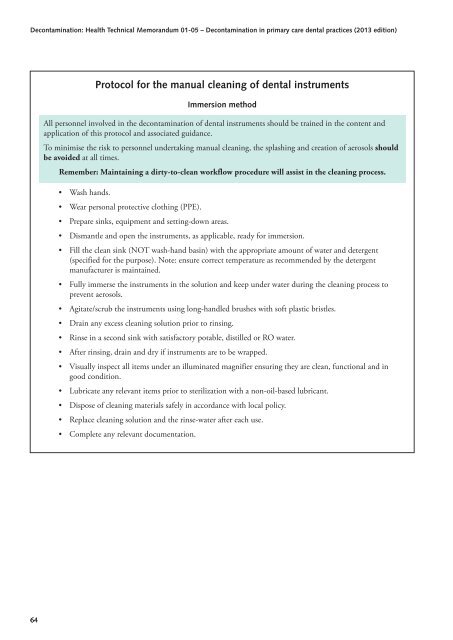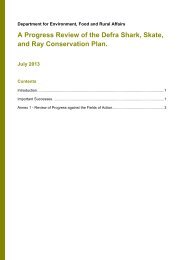Decontamination in primary care dental practices - Gov.uk
Decontamination in primary care dental practices - Gov.uk
Decontamination in primary care dental practices - Gov.uk
You also want an ePaper? Increase the reach of your titles
YUMPU automatically turns print PDFs into web optimized ePapers that Google loves.
<strong>Decontam<strong>in</strong>ation</strong>: Health Technical Memorandum 01-05 – <strong>Decontam<strong>in</strong>ation</strong> <strong>in</strong> <strong>primary</strong> <strong>care</strong> <strong>dental</strong> <strong>practices</strong> (2013 edition)Protocol for the manual clean<strong>in</strong>g of <strong>dental</strong> <strong>in</strong>strumentsImmersion methodAll personnel <strong>in</strong>volved <strong>in</strong> the decontam<strong>in</strong>ation of <strong>dental</strong> <strong>in</strong>struments should be tra<strong>in</strong>ed <strong>in</strong> the content andapplication of this protocol and associated guidance.To m<strong>in</strong>imise the risk to personnel undertak<strong>in</strong>g manual clean<strong>in</strong>g, the splash<strong>in</strong>g and creation of aerosols shouldbe avoided at all times.Remember: Ma<strong>in</strong>ta<strong>in</strong><strong>in</strong>g a dirty-to-clean workflow procedure will assist <strong>in</strong> the clean<strong>in</strong>g process.• Wash hands.• Wear personal protective cloth<strong>in</strong>g (PPE).• Prepare s<strong>in</strong>ks, equipment and sett<strong>in</strong>g-down areas.• Dismantle and open the <strong>in</strong>struments, as applicable, ready for immersion.• Fill the clean s<strong>in</strong>k (NOT wash-hand bas<strong>in</strong>) with the appropriate amount of water and detergent(specified for the purpose). Note: ensure correct temperature as recommended by the detergentmanufacturer is ma<strong>in</strong>ta<strong>in</strong>ed.• Fully immerse the <strong>in</strong>struments <strong>in</strong> the solution and keep under water dur<strong>in</strong>g the clean<strong>in</strong>g process toprevent aerosols.• Agitate/scrub the <strong>in</strong>struments us<strong>in</strong>g long-handled brushes with soft plastic bristles.• Dra<strong>in</strong> any excess clean<strong>in</strong>g solution prior to r<strong>in</strong>s<strong>in</strong>g.• R<strong>in</strong>se <strong>in</strong> a second s<strong>in</strong>k with satisfactory potable, distilled or RO water.• After r<strong>in</strong>s<strong>in</strong>g, dra<strong>in</strong> and dry if <strong>in</strong>struments are to be wrapped.• Visually <strong>in</strong>spect all items under an illum<strong>in</strong>ated magnifier ensur<strong>in</strong>g they are clean, functional and <strong>in</strong>good condition.• Lubricate any relevant items prior to sterilization with a non-oil-based lubricant.• Dispose of clean<strong>in</strong>g materials safely <strong>in</strong> accordance with local policy.• Replace clean<strong>in</strong>g solution and the r<strong>in</strong>se-water after each use.• Complete any relevant documentation.64
















